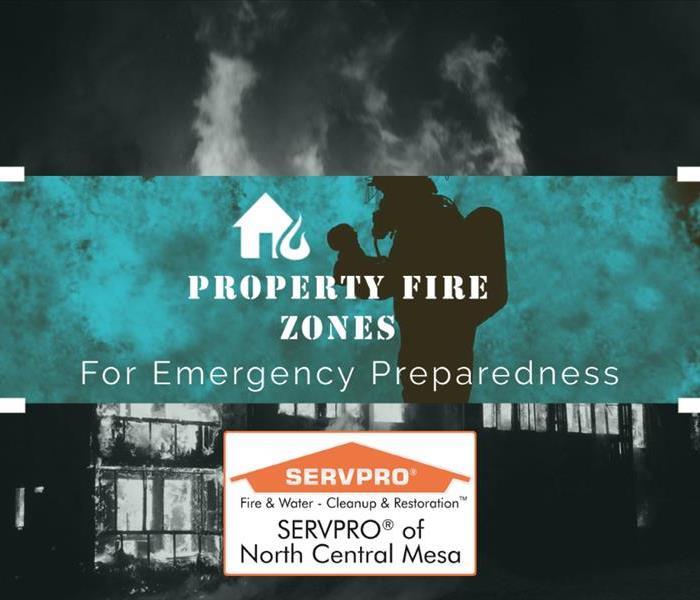Emergency Prep: Home Fire Safety Zones
9/22/2021 (Permalink)
 House on fire in the background with silhouette of firefighter in the middle. With the text "Property Fire zones for Emergency Preparedness" and Logo
House on fire in the background with silhouette of firefighter in the middle. With the text "Property Fire zones for Emergency Preparedness" and Logo
Oh, the horrors of a house fire. If you have been unfortunate enough to experience this firsthand before, then you know how devastating it can be. In Arizona, there have been 4 firefighter fatalities and 15 home fire fatalites in 2021 alone.
But what if there was something that could help prevent your home from catching on fire in the first place? Well, there is! In this blog post we will discuss 3 ignition zones around a property and how to prepare for a potential disaster. We'll also talk about some safety tips that may help keep your family safe during a time when they're most vulnerable.
What is the Home Ignition Zone
Following some groundbreaking experimental research on how houses ignite as a result of radiant heat, retired USDA Forest Service fire scientist Jack Cohen developed the idea of the home ignition zone in the late 1990s. The HIZ is made up of three areas.
Immediate zone
The Immediate Zone is the home and the region 0-5 feet from the furthest connected exterior point of the house, which is deemed a non-combustible area. According to science, this is the most critical zone to act swiftly on since it is most susceptible to embers.
- Gutters and roofing that have been clogged with dead leaves, debris, and pine needles may catch fire. Replace any missing or loose shingles or roof tiles to prevent ember penetration.
- Install 1/8 inch metal mesh screening to reduce embers that may flow through vents in the eaves.
- To prevent embers, clean out the exterior attic vents and install 1/8-inch metal mesh screening.
- Repair or replace damaged or missing window screens, as well as any broken windows. Wire mesh should be used to screen or box in locations beneath patios and decks to prevent debris and combustible materials from accumulating.
- Remove any combustible material from the exterior of the wall – mulch, flammable plants, leaves and needles, firewood piles - anything that might burn. Anything stored beneath decks or porches should be removed.
Intermediate zone
The intermediate Zone is located 5-30 feet from the furthest exterior point of the home. Landscaping/hardscaping - utilizing meticulous landscaping or making gaps that might assist influence and control fire activity
- Large stationary propane tanks should be clear of vegetation.
- Add sections of wood chips or other fuel to the fire. You can also make a fire pit from bricks and metal sheeting on your own, which is an excellent way to entertain guests outdoors in the summer!
- Keep lawns and native grasses trimmed to about of four inches in height.
- Ladder fuels are vegetation under trees which allow fires to reach higher up areas of large trees. You should remove ladder fuels so a fires can't reach the tops of the trees. Trim trees up to 6 or 10 feet from the base; don't prune smaller trees over a third of the tree's overall height.
- Plant trees with enough spacing to have at least 18 feet between crowns. The distance should increase in relation to the percentage of slope.
- To minimize the risk of wind damage, trees should not be planted closer than ten feet from the building's edge.
- Trees and shrubs in this zone should be planted in small groups of three or four to break up the monotony of the vegetation across the field.
Extended zone
The Extended Zone is up to 200 feet from the property's structure, but generally targeted to 30-100 feet from the home. The aim isn't to eliminate fire; rather, it is to obstruct fire's route and keep flames small and on the ground. Landscaping - eliminating afire should be avoided, since this will only hinder efforts for flame control.
- Remove significant accumulations of ground litter/debris.
- Get rid of any dead plant or tree debris.
- Remove small conifers that have sprouted between mature trees.
- Remove any vegetation growing near storage sheds or other outbuildings within this zone.
- Trees should be placed at least 30 to 60 feet from the house, with a minimum distance of 12 feet between canopy tops.*
- There should be at least 6 feet between canopy tops for trees within 60 to 100 feet from the property structure.*
The distances listed for crown spacing are only guidelines based on NFPA 1144. However, due to slope, the species of trees involved, and other site-specific factors, the crown spacing required to reduce or prevent crown fire hazard might be far greater than that suggested by NFPA 1144.
If you need fire damage restoration for your property please give us a call - SERVPRO of North Central Mesa (480) 553-7103
If you are interested in information about preparing your Mesa, Arizona property for a fire, we can help as well. You can call us at the same number above and we will have someone from out community outreach team contact you to set up a free consultation for information.






 24/7 Emergency Service
24/7 Emergency Service